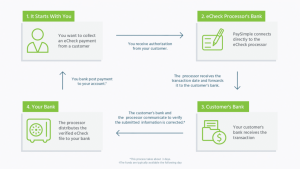As digital payments become more integrated into our daily transactions, businesses and consumers alike are exploring various methods of transferring funds electronically. Among these, electronic checks (eChecks) stand out as an efficient, reliable, and secure payment solution. But how exactly do eChecks work? What are the benefits, and how can businesses set up recurring payments or handle the costs involved? This article will dive into the details of eChecks, with examples, benefits, and real-world case studies to show how businesses can utilize this tool effectively.
What is an electronic check payment?

An eCheck, short for electronic check, is a digital version of a traditional paper check. It allows businesses and individuals to withdraw money from a payer’s checking account electronically, transfer it via the Automated Clearing House (ACH) network, and deposit it into the payee’s account.
This process mirrors the familiar paper check transaction but replaces physical handling with an automated, online process. An important aspect of eCheck transactions is that they must be authorized by the payer, either through an online form, signed contract, or recorded phone conversation.
Example:
Imagine you are a property manager, and your tenants need to pay rent monthly. Instead of waiting for paper checks to clear, you could ask your tenants to set up recurring eCheck payments. They would provide their banking details and authorize the payments. Each month, rent is automatically withdrawn from their bank accounts and deposited into your business account without the hassle of processing physical checks.
How Do electronic check payment Work?
The process of sending and receiving an eCheck involves four key steps:
- Request Authorization: Businesses must gain authorization from the customer to initiate the transaction. This can be done via an online payment form, signed order form, or even a recorded phone conversation.
- Payment Setup: After receiving authorization, businesses input the payment details into their payment processing software.
- Submit Transaction: Once the information is entered, the business submits the payment, and the ACH network processes the transfer.
- Deposit Funds: The payment is automatically withdrawn from the customer’s bank account and deposited into the business’s bank account. Funds typically take three to five business days to clear.
Case Study: Recurring Payments for Legal Services
Law firms often bill clients for services on a recurring basis, especially for retainers or monthly services. A New York-based law firm implemented recurring eCheck payments to streamline their billing process. They asked clients to authorize the payments once, and each month, their fees were automatically withdrawn without clients needing to manually make payments. The firm reported a 25% reduction in missed payments after switching to eChecks.
How Long Does it Take for an electronic check payment to Clear?

The clearing process for eChecks varies depending on the payment provider, but generally, funds are verified within 24 to 48 hours. If the payer has sufficient funds, the payment clears in three to five business days.
For businesses that handle large payments, eChecks provide a more affordable option compared to credit cards, as the fees involved are significantly lower. Moreover, eChecks offer security similar to paper checks, but with the speed and convenience of electronic processing.
The Benefits of Using eChecks for Businesses
eChecks have gained popularity among businesses of all sizes for several reasons. Here are some of the most notable benefits:
- Cost Savings: eCheck processing fees are typically lower than credit card processing fees. While credit card transactions can charge 2-3% of the transaction amount, eChecks usually have a flat fee ranging from $0.30 to $1.50 per transaction.
- Example: A fitness center in Los Angeles switched from credit card payments to eChecks for high-cost memberships. This change saved them nearly $5,000 annually in transaction fees.
- Security: The process of verifying the payer’s information and authorization makes eChecks a secure method of payment. Since the transaction happens through the ACH network, fraud detection is similar to what’s available for traditional bank transfers.
- Convenience: For recurring payments, eChecks simplify the process. Once authorized, they allow automatic payments without needing the customer to manually process each transaction.
- Example: A landlord can set up recurring eCheck payments with tenants, ensuring rent is collected on time each month with minimal hassle.
- Reduced Processing Time: Unlike paper checks, which can take days or even weeks to clear, eChecks generally process in a few business days. This ensures faster access to funds for businesses.
- Environmentally Friendly: Since eChecks eliminate the need for paper, they contribute to environmental sustainability by reducing paper waste.
How to Set Up Recurring eCheck Payments
One of the most popular uses of eChecks is for recurring payments. This feature is commonly used for payments like rent, mortgage, utility bills, and memberships.
Example: A Property Manager’s Perspective
Property managers often ask tenants to fill out an eCheck recurring payment form to authorize automatic rent deductions. Once the authorization is provided, the tenant’s rent is deducted automatically each month, ensuring timely payments. This system also benefits tenants as they no longer need to remember to send a check manually.
Setting up recurring eCheck payments typically involves these steps:
- Get customer authorization through an online form, contract, or recorded phone conversation.
- Input payment details into your payment processing system, including scheduling details for the recurring payments.
- Ensure the transaction processes through the ACH network each month.
eChecks vs. ACH and EFT: Understanding the Difference
The terms eCheck, ACH, and EFT are often used interchangeably, but they have distinct meanings. Here’s a breakdown of these terms:
- EFT (Electronic Funds Transfer): An umbrella term that includes any form of electronic payment, including direct deposits, wire transfers, and eChecks.
- ACH (Automated Clearing House): The network that facilitates electronic transactions, such as eChecks.
- eCheck: A specific type of EFT that utilizes the ACH network to process payments.
Case Study: Reducing Transaction Costs with eChecks
A medium-sized business offering fitness memberships decided to switch to eChecks for processing monthly payments. Before the switch, they were paying 2.5% fees on credit card transactions. After transitioning to eChecks, they only paid a flat fee of $0.75 per transaction, saving them over $10,000 annually. The simplicity of setting up recurring payments also led to a 15% increase in on-time payments.
How Much Does It Cost to Process eChecks?
The cost of processing eChecks varies by provider, but businesses can expect to pay between $0.30 to $1.50 per transaction. The lower transaction fees make eChecks an attractive option, especially for businesses that handle high-cost or recurring payments, where even a small percentage in savings can lead to significant cost reductions.
- Example: A dental clinic switched to eChecks for processing patient payments for expensive procedures, like dental implants. The clinic saved more than $2,000 in transaction fees over the course of a year compared to credit card processing fees.
How to Get an eCheck Merchant Account for Your Business
To accept eChecks, businesses must sign up for an eCheck merchant account. This process is similar to getting a credit card merchant account and requires basic information about the business, including:
- Federal Tax Identification Number (EIN)
- Years in business
- Estimated processing volumes
Once the information is reviewed, approval typically takes a few days, and the business can start processing eChecks. Merchant account providers handle the setup and maintenance of the account, making it simple for businesses to manage electronic transactions.
How to Send and Receive electronic check payments
To send an eCheck, the payer must fill out an online payment form with their checking account and routing numbers. Alternatively, they can provide these details over the phone, which are then entered into an online payment terminal by the payee.
For example, a customer making a mortgage payment can provide their bank details once, authorize recurring payments, and the mortgage will automatically be deducted from their account each month.
Can eChecks Be Canceled?
Once an eCheck has cleared, it cannot be canceled. If the payment is still pending, it may be possible to cancel by contacting the payment processor. Businesses should have clear policies in place for handling payment cancellations and refunds.
Conclusion: Why Businesses Should Consider eChecks
eChecks offer a modern, efficient, and cost-effective way for businesses to process payments. From cost savings to environmental benefits, the advantages are clear. As businesses continue to embrace digital transformation, eChecks will remain a vital tool for simplifying financial transactions, especially for recurring payments and high-value purchases.
By adopting eChecks, businesses can reduce costs, streamline processes, and provide a better experience for their customers. Whether you run a small business or a large corporation, eChecks can help you stay competitive in today’s fast-paced digital landscape.




